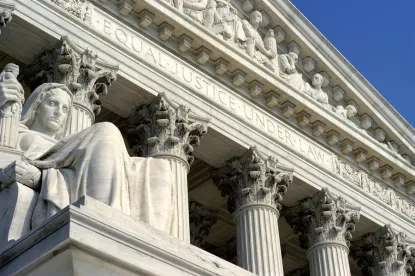Executive Summary
Though largely ignored by recent commentary, the Supreme Court’s recent Campbell-Ewald opinion significantly impacts government contractors’ ability to use the shield of derivative sovereign immunity (“Yearsley immunity”). First, Campbell-Ewald holds that derivative sovereign immunity may shield any government contractor from liability, not just contractors engaged in public works. Second, the Supreme Court clarifies the test for applying Yearsley immunity in a way that benefits government contractors. This and other important considerations are discussed in this post.
Background
On January 20, 2015, the Supreme Court issued its opinion in Campbell-Ewald v. Gomez, in which it reviewed a Ninth Circuit decision to allow a Telephone Consumer Protection Act (TCPA) class action to proceed. Campbell-Ewald Co. v. Gomez, No. 14-857, Supreme Court of the United States (January 20, 2016). The case presented two issues; first, whether an unaccepted offer of complete relief to a class action’s named plaintiff can moot a case; and second, whether “federal contractors share the Government’s unqualified immunity from liability and litigation.” Though the Supreme Court’s holding on the first question—that unaccepted settlement offers cannot moot a case—has grabbed headlines, its less-publicized holding on the second question has significant, and largely positive, implications for government contractors.
The contractor in this case, the Campbell-Ewald Company, is a national marketing firm that contracted with the Navy to send recruiting messages to consenting recipients. Jose Gomez never consented to receiving these texts but received them nonetheless. He then decided that while the Navy might be a “Global Force for Good”, he would rather be a lead plaintiff of one, and filed a class action complaint alleging that Campbell-Ewald violated the TCPA. Among its defenses, Campbell-Ewald, citing Yearsley v. W.A. Ross Constr. Co., 309 U. S. 18, claimed that suit was barred by the doctrine of derivative sovereign immunity. The district court agreed and granted Campbell-Ewald’s motion for summary judgment under Rule 56. The Ninth Circuit reversed.
The Opinion
Justice Ginsburg wrote for a 5-1-3 Court holding that the unaccepted offer of settlement did not moot the case and that Campbell-Ewald was not immunized by derivative sovereign immunity.[1] On the second issue, the Court held that contractors’ ability to invoke derivative sovereign immunity is not absolute and that Campbell-Ewald was not immune from suit. Op. 12. While the Court did not define precisely the parameters of when Yearsley immunity applies, it reached its holding that Campbell-Ewald was not immune from suit only after noting that Campbell-Ewald violated “both federal law and the Government’s explicit instructions.”[2]Id. The reach of this decision may prove to be quite broad, as described below.
I. Yearsley Immunity is Not Limited to Public Works
Perhaps the most significant outcome from Campbell-Ewald is its clarification of the applicability of Yearsley immunity to contractors. Previously, there was disagreement about the scope of Yearsley immunity. The Ninth Circuit described Yearsley as “establish[ing] a narrow rule regarding claims arising out of property damage caused by public works projects.” Op. 13 n.7. Campbell-Ewald expressly rejected this narrow application and held that “[c]ritical in Yearsley was not the involvement of public works, but the contractor’s performance in compliance with all federal directions.” Id.
Citing Yearsley, the Court then held that when “the Government’s ‘authority to carry out the project was validly conferred, that is, if what was done was within the constitutional power of Congress . . . there is no liability on the part of the contractor’ who simply performed as the Government directed.” Op. 13 (internal citation omitted). This eliminates the argument, advanced by the Ninth Circuit and others, that Yearsley is limited to public works. It is now clear that Yearsley’s protections may apply generally to government contractors.
II. The Court Suggests that Yearsley Immunity Defenses Should be Decided At the Outset of the Case
Another important element of Campbell-Ewald, found in multiple references, is clarification that Yearsley immunity is a shield “from suit,” as opposed to a defense against liability. See Op. at 12 (presenting the question as whether Campbell-Ewald was “immune from suit.”); id. (acknowledging that government contractors obtain certain “immunity” for their federal contract work but noting that Yearsley immunity does not “shield[] the contractor from suit” if a contractor “violates both federal law and the Government’s explicit directions”); id. at 14 (similarly acknowledging that the immunity at issue in the case is an “immunity from suit”).
This determination has a number of important consequences. First, because Yearsley immunity is a qualified immunity from suit, district courts should consider and decide whether the doctrine applies at the outset of a case. See Saucier v. Katz, 533 U.S. 194 (2001). Second, if the district court concludes that a contractor does not have Yearsley immunity, then the contractor may obtain immediate appellate review of that decision. See Mitchell v. Forsyth, 472 U.S. 511 (1985); Behrens v. Pelletier, 516 U.S. 299 (1996) (both recognizing the immediately appealable nature of a denial of qualified immunity).
Campbell-Ewald, considering an appeal from a grant of summary judgment under Rule 56, did not have occasion to consider whether Yearsley immunity should be brought under 12(b)(1) or 12(b)(6). See Op. 14 (following the Rule 56 standard, construing “the record in a light favorable to the party seeking to avoid summary disposition, here, Gomez.”). But while this remains an open question, because Campbell-Ewald made clear that it is appropriate to rely on matters outside of the pleadings to establish Yearsley immunity, parties arguably have a basis to bring a motion for Yearsley immunity under 12(b)(1).
III. Refining Yearsley: Do Contractors Have a Presumption of Yearsley Immunity?
Though Campbell-Ewald was clear that Yearsley immunity is not “absolute,” it also suggested that it may presumptively apply to contractors. The Court held that contractors who perform work pursuant to their contractual undertakings with the United States are immune from suit based on that work, unless the contractors act in violation of “clearly established” or “explicit” government directions, instructions, or federal law. Op. 12–13.
Campbell-Ewald held that Yearsley immunity will not apply to a contractor who violates: the express terms of the contract; the government’s explicit directions and instructions; and “clearly established” federal law. Op. 12–13. But there is “‘no liability on the part of the contractor’” when the “Government’s ‘authority to carry out the project was validly conferred’” and the contractor “performed as the Government directed.” Op. 13 (quoting Yearsley, 309 U.S. at 20–21). This test stands in contrast to the Sixth Circuit’s test in Adkisson. See Adkisson v. Jacobs Eng’g Grp., Inc., 790 F.3d 641, 648 (6th Cir. 2015) (holding that “[e]ven if the district court determines that Jacobs is eligible for Yearsley immunity, Jacobs’s exemption from liability will depend on whether its specific conduct at issue would fall under the corollary of the discretionary-function exception of the FTCA.”).
The clarification of the Yearsley standard is significant given the frequency of broad, performance-based tasking contracts that leave contractors with significant discretion as to the means and methods of performance. Plaintiffs may struggle to show that a contractor violated “explicit” instructions when such instructions were not given or contained in the terms of the contract. Further, if government contractors show that the Government inspected a contractor’s work, accepted that work, and paid pursuant to the contract, it follows that plaintiffs cannot show the contractor violated the Government’s explicit instructions. There is an implicit holding here that contractors should not be penalized for exercising the discretion required by the breadth and lack of specificity in a contract or instruction.
Conclusion
Campbell-Ewald is an important and positive development for government contractors seeking Yearsley immunity. First, its holding clarifies that Yearsley immunity applies to all government contractors, not just public works projects. Second, it suggests that contractors have a presumption of Yearsley immunity, particularly when the Government inspects, accepts, and pays for a contract. Third, it supports consideration of Yearsley immunity under 12(b)(1) (or at least at the outset of the case) as opposed to 12(b)(6). Each of these alone constitutes a positive development. When combined, it becomes clear that Campbell-Ewald is a significant advance in government-contractor litigation.
[1] Justice Thomas concurred only in the judgment. None of the dissents discuss the derivative sovereign immunity question.
[2] The use of “explicit instructions” is an interesting word choice. These “explicit instructions” are, presumably, the terms of Campbell-Ewald’s contract.




 />i
/>i
